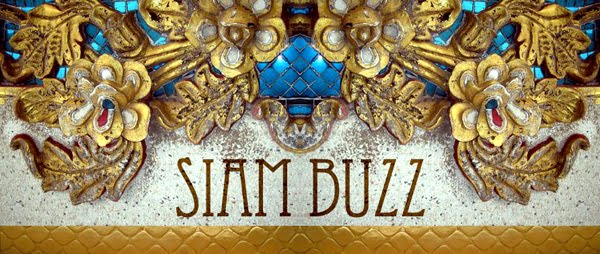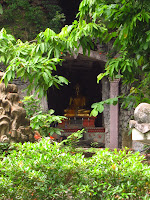 Following my visit to the Golden Mount, I still had plenty of daylight left, surprisingly it doesn’t get dark until quite late, it’s almost as if it’s a European summer. So, from the Golden Mount I made my way down the road with no real direction in mind, I knew there were a few nice places in the area because I’d seen the needle-tipped points of wats from the street as I was walking. As you walk down the street you’ll find yourself on the main road at a large junction, behind you, you have the Golden Mount and in front there’s a monument of King Rama III, which stands in a nice little square in front of Wat Ratchanaddara, which stands out from others because of its black roof and multi-tiered structure.
Following my visit to the Golden Mount, I still had plenty of daylight left, surprisingly it doesn’t get dark until quite late, it’s almost as if it’s a European summer. So, from the Golden Mount I made my way down the road with no real direction in mind, I knew there were a few nice places in the area because I’d seen the needle-tipped points of wats from the street as I was walking. As you walk down the street you’ll find yourself on the main road at a large junction, behind you, you have the Golden Mount and in front there’s a monument of King Rama III, which stands in a nice little square in front of Wat Ratchanaddara, which stands out from others because of its black roof and multi-tiered structure. The temple was either being renovated or repaired and there
was scaffolding along one side but as a result, was completely empty, aside
form a few sleepy looking laborers who lazily looked up as I walked past. I got
the impression I wasn’t really meant to be there but also that no one really
cared to tell me so I wandered around at my own leisure. I couldn’t go in
unfortunately but the outside was beautiful enough.
Have you ever walked to get lost? I did. I knew roughly
where I was and that was too much, so what did I do? I found the narrowest
alley, running parallel to the narrowest aqueduct, and walked down it, only to
come out bang in front of the Giant Swing, or Sao Ching Cha, which is in the center
of a busy street. I’d seen the Swing from taxis to and from the office and I’d
actually not heard of it before, or not to my recollection at least. It looks
as though it should be somewhere in Japan or China and seemed oddly out of place,
impressive though it was.
 The Swing wasn’t always where it is today, it was moved to
its current location in 1920 to make room for a gas plant, which I wont write
about because lets face it, who wants to hear about a gas plant. The Swing
isn’t just a pretty construct though, it was initially used in one of the 12
royal ceremonies, which are held in each of the 12 months of the Thai lunar
calendar to bring in the Brahmin new year, the ceremony lasted for 10 days and
was a re-enactment of an ancient Hindu tale of how Brahma and Shiva first created
and cared for the Earth. The ceremony was also to thank Shiva for a bountiful
rice harvest and pray for the god’s blessing in the next.
The Swing wasn’t always where it is today, it was moved to
its current location in 1920 to make room for a gas plant, which I wont write
about because lets face it, who wants to hear about a gas plant. The Swing
isn’t just a pretty construct though, it was initially used in one of the 12
royal ceremonies, which are held in each of the 12 months of the Thai lunar
calendar to bring in the Brahmin new year, the ceremony lasted for 10 days and
was a re-enactment of an ancient Hindu tale of how Brahma and Shiva first created
and cared for the Earth. The ceremony was also to thank Shiva for a bountiful
rice harvest and pray for the god’s blessing in the next. The thought of people swinging from it is outlandish and the
ceremony was actually discontinued in 1932 due to injuries and deaths, which I
cant say surprises me, although I’m sure that it must have been awesome to
swing from, provided you weren’t one of the unlucky ones.
-- By Tarka Rose (PR intern at Siam Hotels & Resorts)
The thought of people swinging from it is outlandish and the
ceremony was actually discontinued in 1932 due to injuries and deaths, which I
cant say surprises me, although I’m sure that it must have been awesome to
swing from, provided you weren’t one of the unlucky ones.
-- By Tarka Rose (PR intern at Siam Hotels & Resorts)









